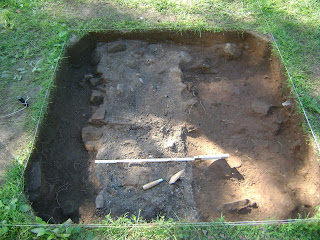We broke ground in the formal garden on May 31st, 2012. The first unit, Unit A, was placed near the Keith house where the GPR survey identified a potential buried wall. With the help of my friends and fellow graduate students Matt and Nydia, we were able to uncover part of the original 18th century garden wall!
This picture shows the closing, or end, of the first level (facing north). You can begin to see some stones poking through the soil.
Here is the closing of level 3. More stones are appearing as well as larger pieces of brick.
The western and eastern sides of the unit had different soils so we excavated them separately. As we excavated, the wall became much more defined.
Some of the larger rocks were still stuck together with mortar and large pieces of brick were found alongside the stones. It is still unclear whether or not the brick was part of the original wall or whether it was from the garden walkways. Because many of the chunks of brick were glazed, it is possible that these decorative bricks were part of the garden wall.
Artifacts such as ceramic, glass, animal bones and teeth, nails, buttons and even the head of a spoon was found in this unit. However, it seems that these artifacts date more to the Penrose period than Elizabeth's. The Penrose family dismantled many of the Graeme's outbuildings and repurposed the materials for their own construction. It can be assumed that the same thing happened to the garden walls. As a result, the garden wall was dismantled, the stones and brick that was desired was removed, and soil full of Penrose-era "garbage" was dumped into the pit that was once the garden wall. However, after further analysis it may be possible that some of the artifacts date to Elizabeth's occupation of the property.
It was very difficult digging through the stones. Although I decided to move on to a new unit, I may return to it in the future to determine the depth of the wall.
Below are pictures of some of the artifacts after they were cleaned:
From left to right (top): Redware, animal bone, animal bone, window glass, mirror glass
From left to right (bottom): Yellowware, yellowware, transferware, transferware, brick, bottle glass
The quarter is there for scale.
More information about this unit and the others will shortly follow! Many thanks to my volunteers for all of their hard work!
Please email me if you have any questions about this excavation or Graeme Park in general.












